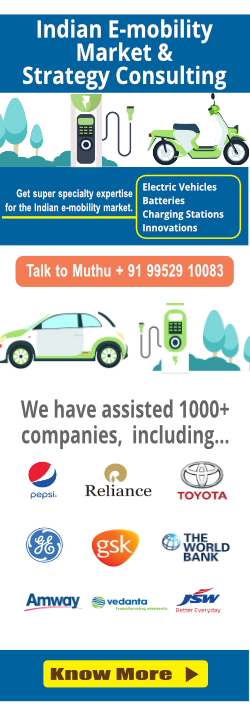This pos![]() t is a part of EV Next’s EV Perspectives.
t is a part of EV Next’s EV Perspectives.
EV Next, a division of EAI, is a leading market intelligence & strategic consulting firm for the Indian e-mobility sector.
Get to know about 1000+ EV innovations from EVI2: Electric Vehicle Innovation Intelligence from EVNext
This post is part of a series titled “Strategizing for E-mobility Opportunities in India” from EV Next Perspectives. See all posts for this series from here. See previous post Current Status of EV Industry in India
Introduction
Until about 2016, electric vehicles had remained a small fringe of the overall automobile industry, more a fancy item for the “statement makers” than a serious competitor to ICE engines. It appears that this is about to change. A combination of factors – lower costs of and better technologies, increasing trend in cost of crude oil, a serious emphasis worldwide to curb vehicular CO2 emissions – are contributing to the growth of the electric vehicle sector.
In India, a similar trend is seen. While overall market volumes for electric vehicles are still very low for all types and segments, it is being hoped that the country will witness dramatic growth in the sales of electric vehicles starting 2018. The reasons for the optimism are similar to the ones noted above.
All said, electric vehicles seem to have arrived in India, or at least such a moment appears round the corner as we review the industry in early 2010. And this has made many businesses and entrepreneurs keen on the opportunities emerging from the electric vehicle sector.
Value Chain for the Electric Vehicle Ecosystem
A number of people, when they approach EVNext, have this question: We know EVs are the future, but we are not sure which part of the value chain we should invest in?
And we tell them that a logical way to figure this out is to undertake a comprehensive review of the EV value chain components and rate each of these components on key operational and strategic parameters. Such an analysis will provide them with a shortlist of opportunities that are more relevant to them.
The starting point hence is a comprehensive review of the EV ecosystem. There are two types of value chain in EV
- The EV OEM value chain
- The EV Li-ion Battery value chain
The electric vehicle value chain consists of raw material extraction, processing, manufacturing, final assembly, and recycling. After their extraction, the raw materials are processed and sent to further manufacturing. The materials are then used for the production of the vehicle components. These components comprise the electric motor, the transmission, the battery, electronics, capacitors, the braking system, structural components, wheels and tires, and the base vehicle. These parts are assembled to the final product. The use phase includes the electricity supply chain and maintenance of the vehicle. It is characterized by the driving and charging patterns of the user. At the end-of-life, the vehicle is disassembled and the resulting parts are either brought to waste disposal, material recovery or reuse to enter a new life cycle. As the key component that distinguishes an electric vehicle from an ICE vehicle is the battery, it will be instructive to review the production value chain for electric vehicle batteries.
Battery production value chain
- Component Production: Manufacturing of raw materials to anode and cathode active materials, binders, Electrolyte, and separator.
- Cell production: Production and assembly of single cells.
- Module production: Configuration of single cells to cell modules with electronic management.
- Pack assembly: Installation of modules together with a system that manages Power, Charging and Temperature(BMS).
- Vehicle integration: Integrating the battery pack into the vehicle and setting up the battery vehicle interface.
- Use: Vehicle battery lifetime
- Recycling and repurposing: Secondary use of battery and recycling to get the materials and components.
Figure1: Electric Vehicle Battery Value Chain (for Li-ion Batteries)
Figure 2: Electric Vehicle Value Chain
This post is part of a series titled “Strategizing for E-mobility Opportunities in India” from EV Next Perspectives. See all posts for this series from here. See next post E-mobility – Evaluating the Opportunities (2020-2030)
The following are the posts in this series:
Read our other blogs: EV Supply Chain | EV Value Chain | FCEV Trends | Indian FCEV R&D | CNG vs EV | Import & Customs |
 Know more on how EV Next can assist your business in your strategy for the e-mobility and electric vehicles sectors, Here
Know more on how EV Next can assist your business in your strategy for the e-mobility and electric vehicles sectors, Here
Wish to know everything about India’s EV market from one place? Check out the India EV Expert Guide, an 800 page comprehensive guide to the Indian EV market. Here
Get to know about 1000+ EV innovations from EVI2: Electric Vehicle Innovation Intelligence from EVNext












